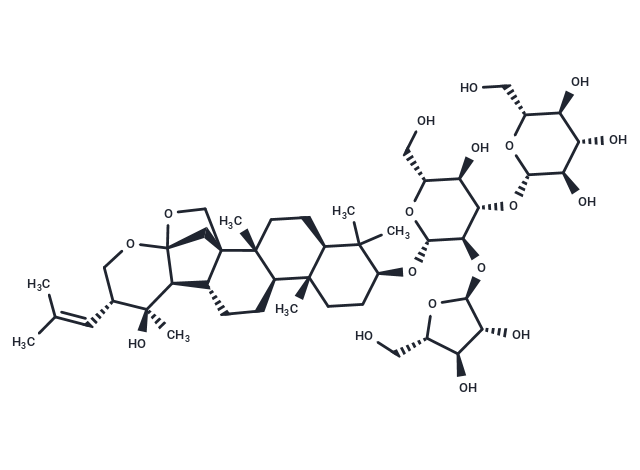Shopping Cart
- Remove All
 Your shopping cart is currently empty
Your shopping cart is currently empty

Bacopaside II is a potential anti-angiogenic agent, it can reduce endothelial cell migration and tubulogenesis and induce apoptosis.

| Pack Size | Price | Availability | Quantity |
|---|---|---|---|
| 1 mg | $68 | In Stock | |
| 5 mg | $196 | In Stock | |
| 10 mg | $295 | In Stock | |
| 25 mg | $497 | In Stock | |
| 50 mg | Inquiry | In Stock | |
| 1 mL x 10 mM (in DMSO) | $319 | In Stock |
| Description | Bacopaside II is a potential anti-angiogenic agent, it can reduce endothelial cell migration and tubulogenesis and induce apoptosis. |
| In vitro | We tested the AQP1 inhibitor, Bacopaside II, derived from medicinal plant Bacopa monnieri, on endothelial cell migration and tube-formation in vitro using mouse endothelial cell lines (2H11 and 3B11) and human umbilical vein endothelial cells (HUVEC). The effect of Bacopaside II on viability, apoptosis, migration and tubulogenesis was assessed by a proliferation assay, annexin-V/propidium iodide flow cytometry, the scratch wound assay and endothelial tube-formation, respectively. Cell viability was reduced significantly for 2H11 at 15 μM (p = 0.037), 3B11 at 12.5 μM (p = 0.017) and HUVEC at 10 μM (p < 0.0001). At 15 μM, the reduced viability was accompanied by an increase in apoptosis of 38%, 50% and 32% for 2H11, 3B11 and HUVEC, respectively. Bacopaside II at ≥10 μM significantly reduced migration of 2H11 (p = 0.0002) and 3B11 (p = 0.034). HUVECs were most sensitive with a significant reduction at ≥7.5 μM (p = 0.037). Tube-formation was reduced with a 15 μM dose for all cell lines and 10 μM for 3B11 (p < 0.0001). |
| Molecular Weight | 929.1 |
| Formula | C47H76O18 |
| Cas No. | 382146-66-9 |
| Smiles | CC(C)=C[C@@H]1CO[C@]23C[C@]4(CO2)[C@H](CC[C@@H]2[C@@]5(C)CC[C@H](O[C@@H]6O[C@H](CO)[C@@H](O)[C@H](O[C@@H]7O[C@H](CO)[C@@H](O)[C@H](O)[C@H]7O)[C@H]6O[C@@H]6O[C@@H](CO)[C@H](O)[C@H]6O)C(C)(C)[C@@H]5CC[C@@]42C)[C@H]3[C@@]1(C)O |
| Relative Density. | 1.43 g/cm3 |
| Storage | store at low temperature,keep away from direct sunlight | Powder: -20°C for 3 years | In solvent: -80°C for 1 year | Shipping with blue ice. | ||||||||||||||||||||
| Solubility Information | DMSO: 10 mM, Sonication is recommended. | ||||||||||||||||||||
Solution Preparation Table | |||||||||||||||||||||
DMSO
| |||||||||||||||||||||

Copyright © 2015-2025 TargetMol Chemicals Inc. All Rights Reserved.